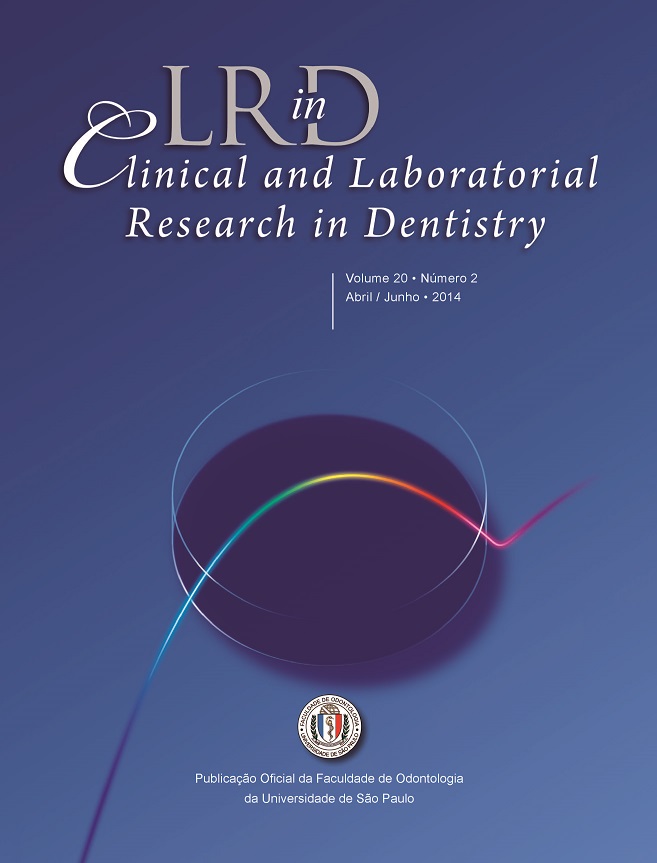Laboratory model to evaluate the influence of stress and corrosion in the formation of non-carious cervical lesions
DOI:
https://doi.org/10.11606/issn.2357-8041.v20i2p117-124Keywords:
Demineralization, Tensile Strength, Dental Enamel, Dentin.Abstract
Objective: To conceive and test a laboratory model that simulates the multifactorial etiology of non-carious cervical lesions. The model enables researchers to assess the pathological process with increasing levels of complexity, focusing on tension and corrosion. The model is aimed at clarifying the mechanisms that lead to the development of these lesions. Methods: Specimens were manufactured from bovine incisors cut into 18 × 3 × 3 mm sticks, with a notch in the cervical region facing the pulp, in order to concentrate the stresses on the surface of the cementum-enamel junction when fi xed at the apical end and loaded for bending on the incisal edge. One group was immersed in distilled water and the other in pH 4.5 acetate buffer for 72 h. Each group was divided into three subgroups: one subgroup without loading, and two subgroups submitted to loading (800 gf) to cause either compression or tensile stress. After the test, 0.05 mm histological lamellae of the specimens were processed and photographed using a light microscope, and the damages were assessed. Conclusion: The laboratory model that was developed enabled the precise measurement of the depth of loss and demineralization of tooth tissue in the specimens, whether submitted to stress or not. The formation of other damages, such as cracks and fractures, could also be observed; this made it possible to infer the infl uence of compressive and tensile stresses on the etiology of non-carious cervical lesions. The model can be further enhanced by making it possible to apply cyclic loads and interspersed abrasive challenges.Downloads
References
Imfeld T. Dental erosion. Definition, classification and links. Eur J Oral Sci. 1996;104:151-5.
Dawid E, Meyer G, Schwartz P. The etiology of wedge-shaped defects: a morphological an funcion oriented investigation. J Gnathol. 1991;10(1):49-55.
Tomasik M. Analysis of etiological factors involved in noncarious cervical lesions. Ann Acad Med Stetin. 2006;52(3):125-36.
Lee WC, Eakle WS. Possible role of tensile stress in the etiology of cervical erosive lesions of teeth. J Prosthet Dent. 1984 Sep;52(3):374-80.
Grippo JO. Abfractions: a new classification of hard tissue lesions of teeth. J Esthet Dent. 1991 Jan-Feb;3(1):14-9.
Khan F, Young WG, Shahabi S, Daley TJ. Dental cervical lesions associated with occlusal erosion and attrition. Aust Dent J. 1999 Sep;44(3):176-86.
Grippo JO, Simring M, Schreiner S. Attrition, abrasion, corrosion and abfraction revisited: a new perspective on tooth surface lesions. J Am Dent Assoc. 2004 Aug;135(8):1109-18; quiz 63-5.
Rees JS, Jagger DC. Abfraction lesions: myth or reality? J Esthet Restor Dent. 2003;15(5):263-71.
Bartlett DW, Shah P. A critical review of non-carious cervical (wear) lesions and the role of abfraction, erosion, and abrasion. J Dent Res. 2006 Apr;85(4):306-12.
Michael JA, Townsend GC, Greenwood LF, Kaidonis JA. Abfraction: separating fact from fiction. Aust Dent J. 2009 Mar;54(1):2-8.
Downloads
Published
Issue
Section
License
Authors are requested to send, together with the letter to the Editors, a term of responsibility. Thus, the works submitted for appreciation for publication must be accompanied by a document containing the signature of each of the authors, the model of which is presented as follows:
I/We, _________________________, author(s) of the work entitled_______________, now submitted for the appreciation of Clinical and Laboratorial Research in Dentistry, agree that the authors retain copyright and grant the journal right of first publication with the work simultaneously licensed under a Creative Commons Attribution License that allows others to share the work with an acknowledgement of the work's authorship and initial publication in this journal. Authors are able to enter into separate, additional contractual arrangements for the non-exclusive distribution of the journal's published version of the work (e.g., post it to an institutional repository or publish it in a book), with an acknowledgement of its initial publication in this journal. Authors are permitted and encouraged to post their work online (e.g., in institutional repositories or on their website) prior to and during the submission process, as it can lead to productive exchanges, as well as earlier and greater citation of published work (See The Effect of Open Access).
Date: ____/____/____Signature(s): _______________


